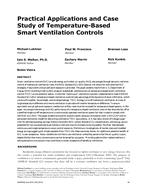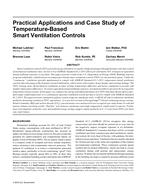Description
Smart ventilation controls (SVC) provide energy and indoor air quality (IAQ) advantages through dynamic real-time control of mechanical ventilation rates. ASHRAE Standard 62.2-2013 (Section 4.6) allows for such alternate SVC strategies, if equivalent annual pollutant exposure is provided. This paper presents results from U.S. Department of Energy (DOE) Building America (BA) program stakeholder collaborations on temperature-based smart ventilation control (TSVC) as one potential option. Unlike the “continuous” ventilation typically implemented to meet ASHRAE Standard 62.2-2013, temperature-based ventilation controls take advantage of the dynamics of stack infiltration, which varies with weather, house height, and envelope leakage. TSVC strategy turns off mechanical ventilation at times of large temperature difference and moves ventilation to periods with smaller temperature differences. To ensure equivalent annual pollutant exposure, mechanical airflow rates must be increased for temperature-based systems. In this paper, we compare the energy and IAQ performance of a temperature-based ventilation control that shuts the fan off at a specified single cut-off temperature to a continuously operated ventilation system fan that is sized to comply with ASHRAE 62.2-2013. This paper presents simulation analysis results using two simulation tools: 1) REGCAP and its advanced ventilation model for detraining ventilation TSVC equivalency, 2) A new beta version of EnergyGauge® USA for estimating energy savings. Relative humidity (RH), carbon dioxide (CO2) concentrations, and energy use are presented for two occupied case study homes in cold and marine climates involving weekly “flip flop” tests between continuous and single temperature cutout control scenarios. Preliminary investigations of market costs and modeled energy savings suggest quick simple paybacks from TSVCs for these case study homes. An additional potential benefit of SVC is user acceptance. Many residents do not like to use ventilation unless they perceive that the air quality is poor, despite the fact that many contaminants cannot be sensed by occupants. Providing options that residents believe is taking dynamics into account may contribute to wider acceptance of beneficial ventilation.
Citation: ASHRAE and AIVC IAQ 2016 Conf
Product Details
- Published:
- 2016
- Number of Pages:
- 6
- Units of Measure:
- Dual
- File Size:
- 1 file , 2.2 MB
- Product Code(s):
- D-2016IAQ-7








